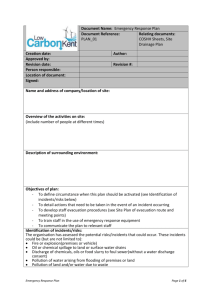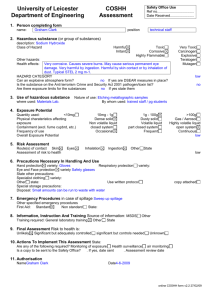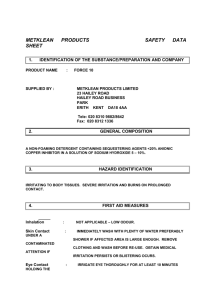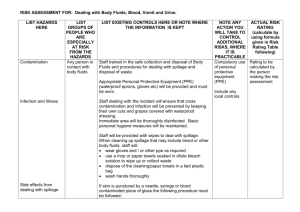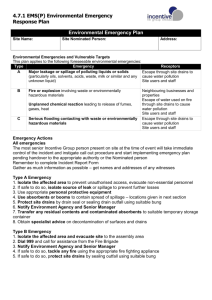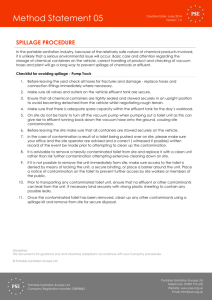STILEBRIDGE GROUNDWORK LTD DEALING WITH CHEMICAL
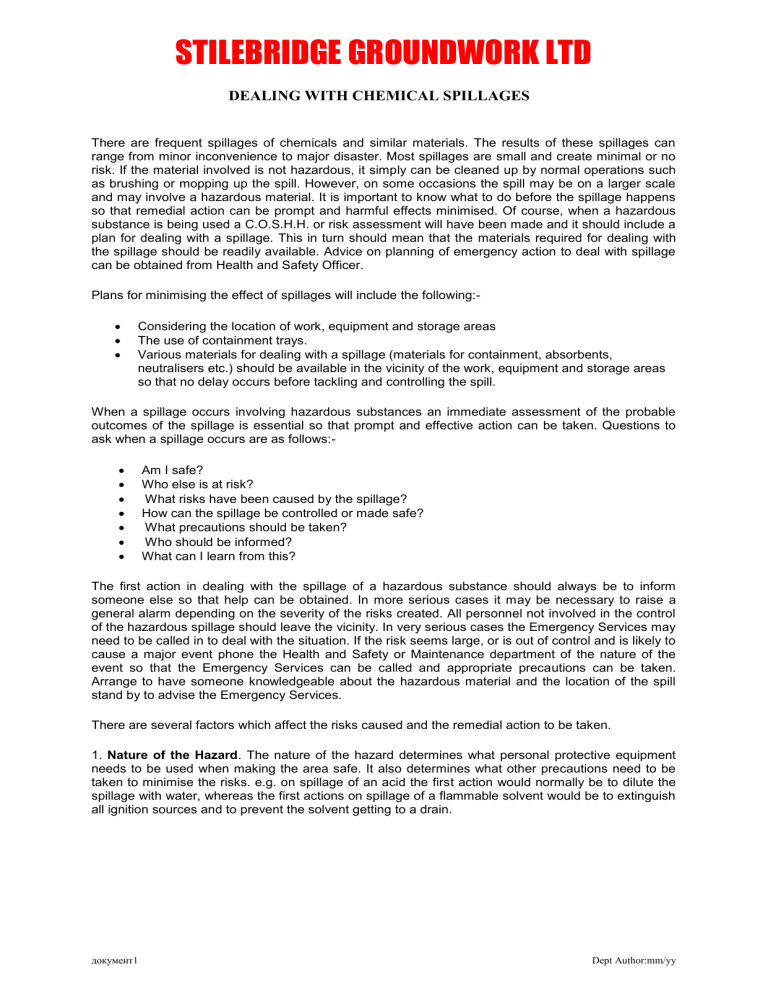
STILEBRIDGE GROUNDWORK LTD
DEALING WITH CHEMICAL SPILLAGES
There are frequent spillages of chemicals and similar materials. The results of these spillages can range from minor inconvenience to major disaster. Most spillages are small and create minimal or no risk. If the material involved is not hazardous, it simply can be cleaned up by normal operations such as brushing or mopping up the spill. However, on some occasions the spill may be on a larger scale and may involve a hazardous material. It is important to know what to do before the spillage happens so that remedial action can be prompt and harmful effects minimised. Of course, when a hazardous substance is being used a C.O.S.H.H. or risk assessment will have been made and it should include a plan for dealing with a spillage. This in turn should mean that the materials required for dealing with the spillage should be readily available. Advice on planning of emergency action to deal with spillage can be obtained from Health and Safety Officer.
Plans for minimising the effect of spillages will include the following:-
Considering the location of work, equipment and storage areas
The use of containment trays.
Various materials for dealing with a spillage (materials for containment, absorbents, neutralisers etc.) should be available in the vicinity of the work, equipment and storage areas so that no delay occurs before tackling and controlling the spill.
When a spillage occurs involving hazardous substances an immediate assessment of the probable outcomes of the spillage is essential so that prompt and effective action can be taken. Questions to ask when a spillage occurs are as follows:-
Am I safe?
Who else is at risk?
What risks have been caused by the spillage?
How can the spillage be controlled or made safe?
What precautions should be taken?
Who should be informed?
What can I learn from this?
The first action in dealing with the spillage of a hazardous substance should always be to inform someone else so that help can be obtained. In more serious cases it may be necessary to raise a general alarm depending on the severity of the risks created. All personnel not involved in the control of the hazardous spillage should leave the vicinity. In very serious cases the Emergency Services may need to be called in to deal with the situation. If the risk seems large, or is out of control and is likely to cause a major event phone the Health and Safety or Maintenance department of the nature of the event so that the Emergency Services can be called and appropriate precautions can be taken.
Arrange to have someone knowledgeable about the hazardous material and the location of the spill stand by to advise the Emergency Services.
There are several factors which affect the risks caused and the remedial action to be taken.
1. Nature of the Hazard . The nature of the hazard determines what personal protective equipment needs to be used when making the area safe. It also determines what other precautions need to be taken to minimise the risks. e.g. on spillage of an acid the first action would normally be to dilute the spillage with water, whereas the first actions on spillage of a flammable solvent would be to extinguish all ignition sources and to prevent the solvent getting to a drain. документ1
Dept Author:mm/yy
STILEBRIDGE GROUNDWORK LTD
DEALING WITH CHEMICAL SPILLAGES
2. Physical State . The physical state of the material can increase risks and the difficulty in decontaminating the area of the spillage. Solid materials are usually the easiest to control, but fine dusts once liberated behave in a similar manner to gases and are difficult to control. The use of ventilation and a suitable respirator will probably be necessary while decontaminating a major spillage of hazardous fine dust.
Liquids, being more mobile than solids, are more difficult to control after a spillage. They are often volatile or generate fumes and aerosols after a spillage; in these cases ventilation of the spillage area and use of a suitable respirator will probably be required when decontaminating the affected area.
Spilled liquids should be contained, absorbed, diluted or neutralised. The use of containment is to prevent the spillage from spreading to a larger area and can be accomplished with commercial spill kits or improvised barriers of towels, sand or other available materials. Spillages of flammable solvents should be contained to prevent them from entering the drainage system. Liquids can be absorbed into a solid such as paper tissues, Spill absorbent materials or sand which can swept up and placed in a closed container for future treatment. Dilution is used to lower the risk from the liquid e.g. spilled liquid acids should be diluted with water and then neutralised with a carbonate such as sodium carbonate or bicarbonate and then absorbed or mopped up. If the liquid is flammable and water immiscible do not try to dilute this with water since the solvent will float on the surface and be spread over a wider area thus increasing the risk of fire.
Some substances on their own or in contact with the air or water can generate hazardous gases or vapours. Being gases these are difficult to control and often require the use of appropriate respirators and ventilation of the area where the spillage occurred.
3. Scale of a Spillage . The larger the spillage the greater the risk and the more likely that the
Emergency Services will be needed. The risk of major incidents following large volume spillages of flammable solvents, volatile toxic substances or corrosive substances is high.
4. The number of people who can be affected by exposure to the Spillage . Obviously the more people who can be exposed to the hazardous substance the greater the risk. Therefore all personnel not involved in the cleaning up of the spillage should be evacuated to a safe area until the spillage is declared safe.
5. Location of the Spillage . The risks arising from a spillage vary widely from one location to another.
The spillage of a 25lt barrel of oil in a Storage area creates a large risk but the same spillage in workshop creates a risk of a significantly higher magnitude. Therefore, when transporting hazardous materials through busy areas or inside of buildings special precautions should be observed.
Transportation of hazardous materials outside should ideally be in sealed containers. Also, the existence of other factors in the location of the spillage will affect the risk created e.g. ignition sources next to a spillage of flammable solvent. The liberation of Liquid Petroleum Gases (LPG) in or near basements or other low areas can produce a range of particular risks. These gases collect in low areas potentially leading to asphyxiation from displacement of oxygen. Further risk of a major explosion could also occur if a dense flammable gases are allowed to collect in a low, unventilated area. документ1
Dept Author:mm/yy
